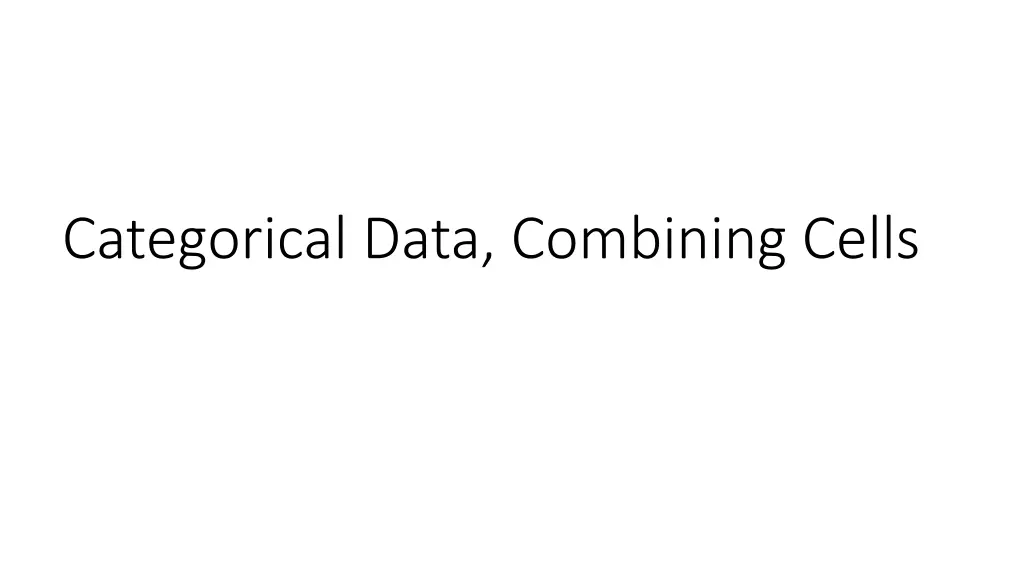
Diminish Categorical Data for Effective Modeling
Discover how to combine cells and categories, apply subject-matter considerations to reduce dimension, and utilize data-driven methods like Greenacre's technique for categorical inputs in predictive modeling. Learn the process of merging levels based on statistical reduction to enhance accuracy and efficiency while mitigating potential information loss.
Download Presentation

Please find below an Image/Link to download the presentation.
The content on the website is provided AS IS for your information and personal use only. It may not be sold, licensed, or shared on other websites without obtaining consent from the author. If you encounter any issues during the download, it is possible that the publisher has removed the file from their server.
You are allowed to download the files provided on this website for personal or commercial use, subject to the condition that they are used lawfully. All files are the property of their respective owners.
The content on the website is provided AS IS for your information and personal use only. It may not be sold, licensed, or shared on other websites without obtaining consent from the author.
E N D
Presentation Transcript
proc proc freq tables smoking*chd/nocol nopercent chisq; run run; freq data=a.chd2018_a; Tobacco Control: Reversal of Risk After Quitting Smoking (IARC Handbooks of Cancer Prevention in Tobacco Control) 1st Edition
Ideally, subject-matter considerations should be used to collapse levels (reduce the dimension) of categorical inputs. This is not always practical in predictive modeling. A simple data-driven method for collapsing levels of contingency tables was developed by Greenacre (1988, 1993). The levels (rows) are hierarchically clustered based on the reduction in the chi-squared test of association between the categorical variable and the target.
At each step, the two levels that give the least reduction in the chi- squared statistic are merged. The process is continued until the reduction in chi-squared drops below some threshold (for example, 99%). This method will quickly throw rare categories in with other categories that have similar marginal response rates. While this method is simple and effective, there is a potential loss of information because only univariate associations are considered.
proc proc freq tables smoking*chd/nocol nopercent chisq; run run; freq data=a.chd2018_a; data data tmp; set a.chd2018_a; currsmok=smoking=2 2; currpast=smoking ne 0 0; currnever=smoking ne 1 1; run run; proc proc freq tables currsmok*chd currpast*chd currnever*chd/nocol nopercent chisq; run run; freq data=tmp;
%clearall clearall data data a.chd2018_a(drop=smoking); set a.chd2018_a; currsmok=smoking=2 2; run run;
%clearall clearall; libname a "d:\dropbox\chd2018\_data"; data data a.chd2018_a (drop=c_chd c_diab gender c_smoking sbp1-sbp3 dbp1-dbp3 weight height fvc set s5238.chd2018(rename=(chd=c_chd diab=c_diab smoking=c_smoking)); chd=c_chd="Developed Chd"; diab=c_diab="Diabetic"; select (c_smoking); end; male=gender="Male"; sbp=mean(of sbp1-sbp3); dbp=mean(of dbp1-dbp3); bmi=(weight/height**2 2)*703 fvcht=fvc/height; run run; /*add indicators for missingness*/ data data a.chd2018_a; set a.chd2018_a; mi_chol=chol=. .; mi_hem=hematocrit=. .; run run; /*do median imputation by gender*/ proc proc sort sort data=a.chd2018_a; by male; run run; subscap); when ("Never Smoker") smoking=0 0; when ("Past Smoker") smoking=1 1; when ("Current Smok") smoking=2 2; otherwise smoking=. .; 703; proc proc stdize stdize data=a.chd2018_a method=median reponly out=a.chd2018_a; by male; var pulse chol hematocrit bmi fvcht; run run; /*randomly distribute unknown smoking status*/ data data a.chd2018_a; set a.chd2018_a; if not male and smoking=. . then smoking=rand("table",.472 else if male and smoking=. . then smoking=rand("table",.236 run run; /*combine past and never smokers*/ %clearall clearall .472,.123 .236,.0627 .123)-1 1;/*female*/ .0627)-1 1;/*male*/ data data a.chd2018_a(drop=smoking); set a.chd2018_a; currsmok=smoking=2 2; run run; proc proc means means data=a.chd2018_a; run run;
Quasi-Complete Separation 0 1 DA DB Dc DD A 28 7 1 0 0 0 B 16 0 0 1 0 0 0 0 1 0 C 94 11 0 0 0 1 D 23 21
data data cluster; input level $ outcome num @@; datalines; A 0 28 B 0 16 C 0 94 D 0 23 A 1 7 B 1 0 C 1 11 D 1 21 ; proc proc freq freq data=cluster; tables level*outcome/nocol nopercent chisq; weight num; run run;
proc proc logistic logistic; class level(param=ref ref="A"); model outcome=level; freq num; run run;
Clustering Levels 0 1 A 28 7 B 16 0 C 94 11 D 23 21 Merged: 2= 31.7 100% ...
%let m1=A; %let m2=B; data data new; set cluster; if level="&m1" or Level="&m2" then newlevel="&m1.+&m2"; else newlevel=level; proc proc freq tables newlevel*outcome/norow nocol nopercent chisq; weight num; run run; freq data=new;
Clustering Levels 0 1 0 1 A 28 7 28 7 B 16 0 110 11 C 94 11 23 21 D 23 21 Merged: B & C 2= 31.7 100% 30.7 97% ...
Clustering Levels 0 1 0 1 A 0 1 28 7 28 7 B 16 0 138 18 110 11 C 23 21 94 11 23 21 D 23 21 Merged: B & C A & BC 2= 31.7 100% 30.7 97% 28.6 90% ...
Clustering Levels 0 1 0 1 A 0 1 28 7 0 1 28 7 B 16 0 138 18 110 11 161 39 C 23 21 94 11 23 21 D 23 21 Merged: B & C A & BC ABC & D 2= 31.7 100% 30.7 97% 28.6 90% 0 0%
Clustering Levels of Categorical Inputs with Proc Cluster The levels of a categorical input can be clustered using Greenacre s method (1988, 1993) in PROC CLUSTER. PROC CLUSTER was designed for general clustering applications, but with some simple pre-processing of the data, it can be made to cluster levels of categorical variables.






















